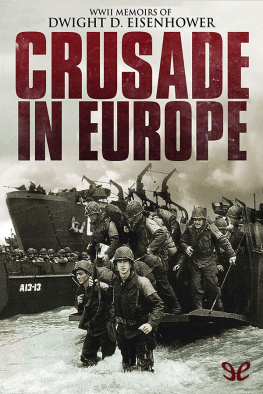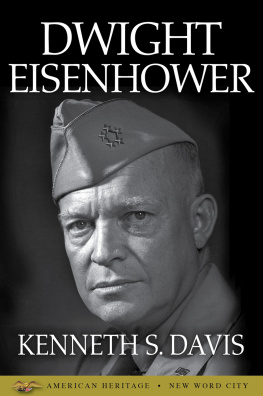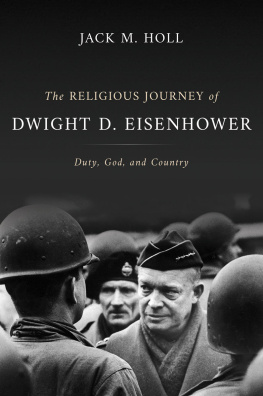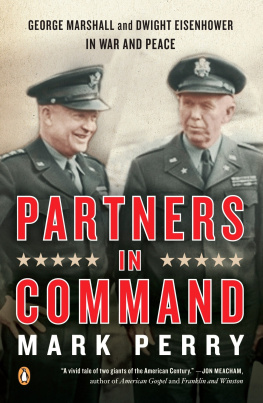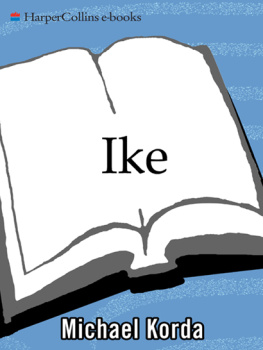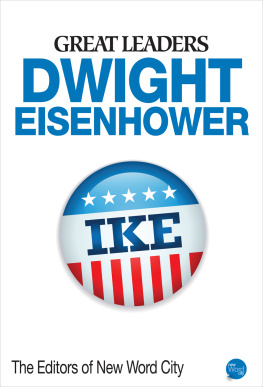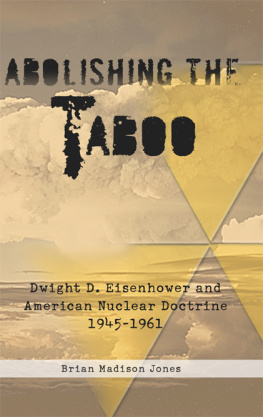Dwight D. Eisenhower - Crusade in Europe
Here you can read online Dwight D. Eisenhower - Crusade in Europe full text of the book (entire story) in english for free. Download pdf and epub, get meaning, cover and reviews about this ebook. year: 1948, publisher: ePubLibre, genre: History. Description of the work, (preface) as well as reviews are available. Best literature library LitArk.com created for fans of good reading and offers a wide selection of genres:
Romance novel
Science fiction
Adventure
Detective
Science
History
Home and family
Prose
Art
Politics
Computer
Non-fiction
Religion
Business
Children
Humor
Choose a favorite category and find really read worthwhile books. Enjoy immersion in the world of imagination, feel the emotions of the characters or learn something new for yourself, make an fascinating discovery.
- Book:Crusade in Europe
- Author:
- Publisher:ePubLibre
- Genre:
- Year:1948
- Rating:3 / 5
- Favourites:Add to favourites
- Your mark:
- 60
- 1
- 2
- 3
- 4
- 5
Crusade in Europe: summary, description and annotation
We offer to read an annotation, description, summary or preface (depends on what the author of the book "Crusade in Europe" wrote himself). If you haven't found the necessary information about the book — write in the comments, we will try to find it.
Crusade in Europe — read online for free the complete book (whole text) full work
Below is the text of the book, divided by pages. System saving the place of the last page read, allows you to conveniently read the book "Crusade in Europe" online for free, without having to search again every time where you left off. Put a bookmark, and you can go to the page where you finished reading at any time.
Font size:
Interval:
Bookmark:
PRELUDE
TO WAR
IN THE ALLIED HEADQUARTERS AT REIMS, Field Marshal Jodl signed the instrument of German surrender on May 7, 1945. At midnight of the next day there ended, in Europe, a conflict that had been raging since September 1, 1939.
Between these two dates millions of Europeans had been killed. All Europe west of the Rhine had, with minor exceptions, lived for more than four years under the domination of an occupying army. Free institutions and free speech had disappeared. Economies were broken and industry prostrated. In Germany itself, after years of seeming invincibility, a carpet of destruction and desolation had spread over the land. Her bridges were down, her cities in ruins, and her great industrial capacity practically paralyzed. Great Britain had exhausted herself economically and financially to carry on her part of the war; the nation was almost entirely mobilized, with everybody of useful age, men and women alike, either in the armed forces or engaged in some type of production for war. Russian industry west of the Volga had been almost obliterated.
America had not been spared: by V-J Day in the Pacific, 322,188 of her youth had been lost in battle or had died in the service and approximately 700,000 more had been wounded. The nation had poured forth resources in unstinted measure not only to support her own armies and navies and air forces but also to give her Allies equipment and weapons with which to operate effectively against the common enemy. Each of the Allies had, according to its means, contributed to the common cause but America had stood pre-eminent as the arsenal of democracy. We were the nation which, from the wars beginning to its end, had achieved the greatest transformation from almost complete military weakness to astounding strength and effectiveness.
Europe had been at war for a full year before America became alarmed over its pitifully inadequate defenses. When the nation began, in 1939, first steps toward strengthening its military establishment, it started from a position as close to zero as a great nation could conceivably have allowed itself to sink.
That summer the Germans were massing against the Polish frontiers 60 infantry divisions, 14 mechanized and motorized divisions, 3 mountain divisions, more than 4000 planes, and thousands of tanks and armored cars. To oppose them the Poles could mobilize less than a third that strength in all categories. Their force was doomed to quick destruction under the fury and weight of the German assault. But the Polish Army, easy victim though it was to Hitlers war machine, far surpassed the United States Army in numbers of men and pieces of equipment.
On July 1, 1939, the Armys enlisted strength in the United Statesair, ground, and servicewas less than 130,000; of three organized and six partially organized infantry divisions, not one approached its combat complement; there were two cavalry divisions at less than half strength; but there was not one armored division, and the total number of men in scattered tank units was less than 1500; the entire Air Force consisted of approximately 1175 planes, designed for combat, and 17,000 men to service, maintain, and fly them. Overseas, to hold garrisons from the Arctic Circle to the Equator and from Panama to Corregidor, eight thousand miles away, there were 45,300 soldiers.
Two increases, authorized during the summer and fall of 1939, raised the active Army at home and overseas to 227,000. But there it remained during the eight months that Germany, brutally triumphant over Poland, was readying her full might for the conquest of western Europe.
The American people still believed that distance provided adequate insulation between us and any conflict in Europe or Asia. Comparatively few understood the direct relationship between American prosperity and physical safety on the one hand, and on the other the existence of a free world beyond our shores. Consequently, the only Americans who thought about preparation for war were a few professionals in the armed services and those far-seeing statesmen who understood that American isolation from any major conflict was now completely improbable.
In the spring of 1940, with the German seizure of Denmark and Norway, the blitz that swept from the Rhine through France to the Bay of Biscay, and the crippled retreat of the British Army from Dunkirk, America began to grow uneasy. By the middle of June the Regular Armys authorized strength had been increased to 375,000. By the end of August, Congress had authorized mobilization of the National Guard; six weeks later Selective Service was in operation. By the summer of 1941 the Army of the United States, composed of regulars, Guardsmen, and citizen soldiers, numbered 1,500,000. No larger peacetime force had ever been mustered by this country. It was, nevertheless, only a temporary compromise with international fact.
The million men who had come into the Army through the National Guard and Selective Service could not be required to serve anywhere outside the Western Hemisphere or for more than twelve months at home. In the summer of 1941, consequently, with the Germans racing across Russia and their Japanese ally unmistakably preparing for the conquest of the far Pacific, the Army could only feebly reinforce overseas garrisons.
The attack at Pearl Harbor was less than four months away when, by a one-vote margin in the House of Representatives, the Congress passed the Selective Service Extension Act, permitting the movement of all Army components overseas and extending the term of service. The congressional action can be attributed largely to the personal intervention of General George C. Marshall, who had already attained a public stature that gave weight to his urgent warning. But even he could not entirely overcome the conviction that an all-out effort for defense was unnecessary. Limitations on service, such as the release of men of the age of twenty-eight, reflected a continuing belief that there was no immediate danger.
Thus for two years, as war engulfed the world outside the Americas and the Axis drove relentlessly toward military domination of the globe, each increase in the size, efficiency, and appropriations of the armed services was the result of a corresponding decrease in the complacency of the American people. But their hesitation to abandon compromise for decisive action could not be wholly dispelled until Pearl Harbor converted the issue into a struggle for survival.
Thereafter, in the space of three and a half years, the United States produced the fighting machine that played an indispensable role in beating Germany to its knees, even while our country, almost single-handed, was conducting a decisive war against the Japanese Empire.
The revolutionary transformation of America was not achieved overnight; the fact that it was ever achieved at all was due to the existence of staunch allies and our own distance from the scene of combat. At the outset none of us could foresee the end of the struggle; few of us saw eye to eye on what was demanded of us as individuals and as a nation; but each began, step by step, to learn and to perform his allotted task.
Americas transformation, in three years, from a situation of appalling danger to unparalleled might in battle was one of the two miracles that brought Jodl to our headquarters to surrender on May 7, 1945. The other was the development, over the same period, of near perfection in allied conduct of war operations. History testifies to the ineptitude of coalitions in waging war. Allied failures have been so numerous and their inexcusable blunders so common that professional soldiers had long discounted the possibility of effective allied action unless available resources were so great as to assure victory by inundation. Even Napoleons reputation as a brilliant military leader suffered when students in staff colleges came to realize that he always fought against coalitionsand therefore against divided counsels and diverse political, economic, and military interests.
Font size:
Interval:
Bookmark:
Similar books «Crusade in Europe»
Look at similar books to Crusade in Europe. We have selected literature similar in name and meaning in the hope of providing readers with more options to find new, interesting, not yet read works.
Discussion, reviews of the book Crusade in Europe and just readers' own opinions. Leave your comments, write what you think about the work, its meaning or the main characters. Specify what exactly you liked and what you didn't like, and why you think so.

